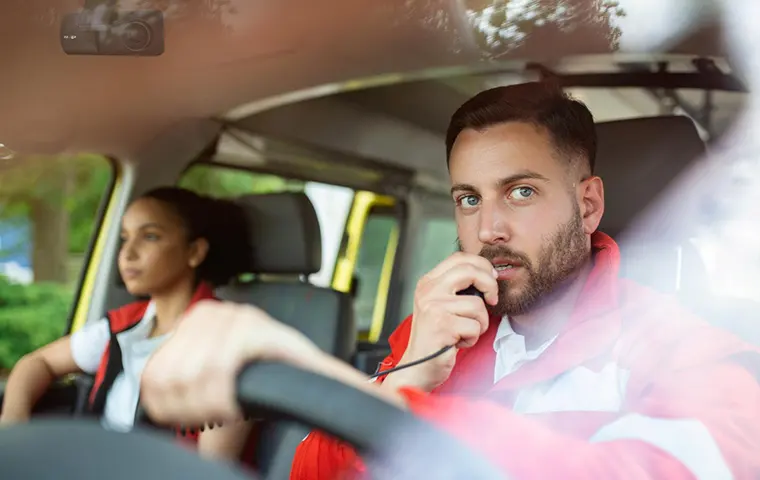Emergency vehicle fleets are essential for ensuring the safety of our citizens. Furthermore, operating emergency vehicles often means high speeds and complex maneuvers. It’s easy to see how emergency fleet managers have an immense responsibility. To increase safety for their drivers and everyone on the road, many emergency vehicle fleet managers incorporate dashcams. These cameras are crucial for keeping roads safe and making sure drivers follow their training.
Whether it's a high-speed police chase or a rush to the hospital, dashcams record everything. Recordings provide clear evidence of what happened in case of an incident. Our emergency vehicle dashcam guide will cover the best ways to pick and use dashcams to help emergency vehicles do their jobs better.
3 Benefits of Dashcams in Emergency Vehicles
Installing dashcams in emergency vehicles brings several advantages, from improving safety on the road to providing undeniable evidence in the event of an accident. Here’s how dashcams in emergency vehicles can make a difference:
No. 1: Evidence Collection
In the event of an accident or incident, dashcams offer clear, firsthand footage. Recorded content can be critical for legal cases, insurance claims, and internal reviews. For police cars, this means having an unbiased witness to every stop and pursuit. For ambulances, it helps in understanding the circumstances leading to any emergencies or accidents.
No. 2: Performance Review
Emergency vehicle fleet managers can use dashcam footage to assess and enhance driver performance. It's helpful when evaluating response times, adherence to driving protocols, and maneuvering skills in high-pressure situations. It's a tool for continuous improvement, ensuring drivers meet the high standards expected in emergencies.
No. 3: Increased Safety
By monitoring driving habits and providing real-time feedback, dashcams encourage safer driving practices. They act as a deterrent against reckless driving, knowing that all actions are recorded. As a deterrent, they protect both emergency vehicle drivers and the public.
Incorporating dashcams into emergency vehicle fleets is a step toward more accountable, transparent, and safe operations. Whether it's for dashcams in police/fire vehicles or the best dashcams for ambulances, the benefits are clear and significant. They help ensure that every decision made on the road is informed, justified, and in the best interest of public safety.
Choosing the Right Dashcam for Emergency Vehicles
Selecting the right dashcam for an emergency fleet is crucial. You must be able to capture high-quality footage you can rely upon in any situation. These are five key factors to consider when shopping for your dashcam.
- Durability and Reliability: Emergency vehicles operate in extreme conditions, from high-speed pursuits to navigating through heavy traffic. Dashcams must withstand these conditions, ensuring continuous operation without failure.
- Video Quality: High-resolution video is non-negotiable. In critical moments, details like license plates, street signs, and faces must be clear. Night vision capabilities are also vital for capturing clear footage in low-light conditions.
- Wide-Angle Lens: A dashcam with a wide viewing angle provides a comprehensive view of the surroundings, capturing more of the scene around the vehicle. A broad view is crucial for a complete understanding of any incident.
- Ease of Use and Integration: Dashcams should be user-friendly, allowing for easy installation, operation, and data retrieval without requiring extensive training. Integration with existing systems in the vehicle for seamless operation is also a key factor.
- Storage and Data Management: You’ll need adequate storage capacity and efficient data management solutions for handling large volumes of video. Automatic backup features and cloud storage options can enhance data security and accessibility.
To choose the right dashcam, you must balance these factors to meet the unique needs of your emergency fleet. By prioritizing dashcam selection, emergency fleet managers can ensure their teams have the necessary tools to perform their duties safely and effectively.
Best Practices for Implementing Dashcams in Emergency Vehicles
Proper installation and use of dashcams in emergency vehicles are vital for maximizing their benefits. Here are some best practices to ensure effective operation:
No. 1: Strategic Placement
Install dashcams to cover critical angles, both facing the road and inside the vehicle. For emergency vehicles, position cameras so they can capture interactions at traffic stops, patient care areas in ambulances, and the response tactics of fire vehicles at scenes. Evaluate your placement to avoid interference with equipment or the safe operation of the vehicle.
No. 2: Regular Maintenance
As with any fleet, you’ll need a solid maintenance routine that includes your dashcam. Emergency fleet managers might focus more heavily on checking the dashcam's power supply, memory capacity, and mounting stability. Emergency vehicles go through a lot of rigorous use. Therefore, it’s vital to ensure that cameras are always operational, lenses are clean, and recordings are not interrupted. This maintenance ensures that crucial moments are captured without fail.
No. 3: Data Management
Develop a secure, efficient system for storing and managing dashcam footage. Dashcams generate a high volume of data that you’ll need to account for. Use encryption for storage and transfer to protect privacy. Categorize footage by incident type and urgency, ensuring quick access for review or evidence while maintaining your data’s security.
No. 4: Privacy Considerations
Be mindful of privacy laws and regulations. Emergency vehicles often operate in situations where people expect privacy. Such situations might include hospitals or accident scenes. Regularly review and update policies to comply with legal requirements and community expectations. Informing the public about the use of dashcams can help manage privacy concerns.
No. 5: Comprehensive Training
Offer detailed training sessions focused on the aspects of dashcams specific to emergency response. Users should have instruction on several topics, including:
- Quickly transferring or securing footage following incidents
- Legal considerations of recording in public and private spaces
- Ethical handling of sensitive situations captured on video
No. 6: Adapting to Technological Advances
Stay updated with technological advancements in dashcam features such as automatic activation based on emergency lights or sirens, integration with vehicle telematics, and live streaming capabilities. Evaluating and integrating these technologies can enhance your dashcams’ effectiveness in capturing critical footage during emergency responses.
These tips help your organization ensure that your dashcam systems are compliant with legal and ethical standards and optimized for the challenges of emergency operations.
Azuga’s AI SafetyCam for Emergency Vehicles
With this guide and the right dashcam setup, you can significantly boost the safety and efficiency of emergency vehicle operations. With its advanced AI technology, Azuga’s AI Safety Cam is designed to meet the demanding needs of emergency fleets. Explore the benefits firsthand by trying out a demo of Azuga's AI Safety Cam. It’s your first step toward safer, smarter emergency responses.








